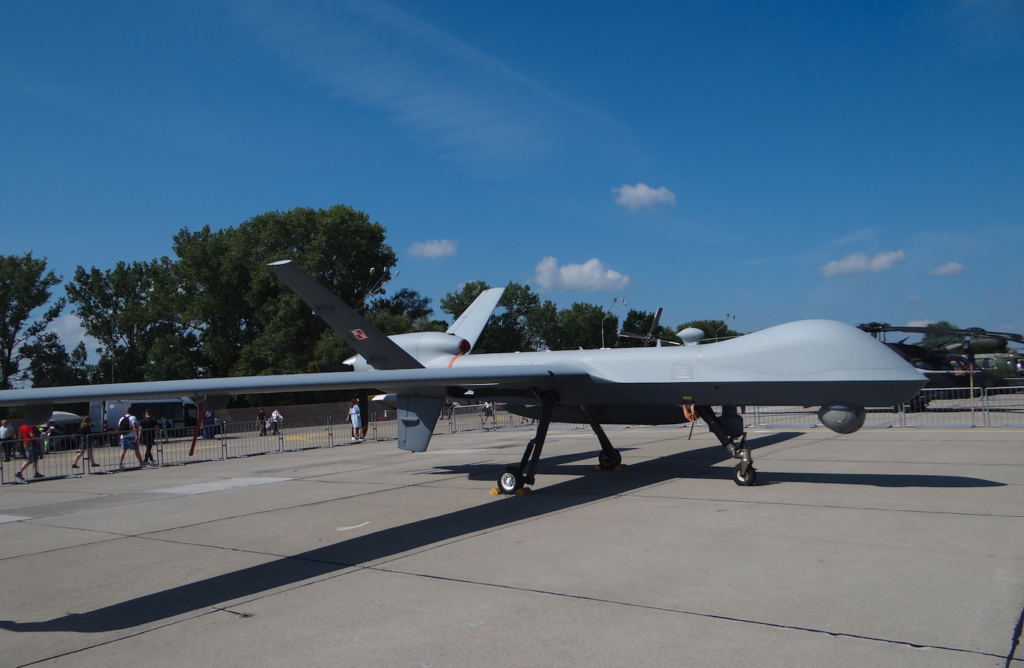Mińsk Mazowiecki 2024-12-06
General Atomics MQ-9 Reaper.
BAL stands for Unmanned Aerial Vehicle. The General Atomics MQ-9 Reaper is an American combat unmanned aerial vehicle designed for long-distance flights at high altitudes. The name “Reaper” means “Żniwiarz” in Polish.




The MQ-9 Reaper aircraft made its first flight on February 2, 2001. It was introduced into service on May 1, 2007. The MQ-9 Reaper is a development of the General Atomics MQ-1 Predator. The General Atomics MQ-9 Reaper is sometimes referred to as the Predator B. The aircraft is capable of performing either controlled or autonomous missions. The MQ-9 Reaper is the first hunter-killer unmanned aerial vehicle designed for long-duration surveillance at high altitudes.
The MQ-9 Reaper is a larger, heavier, and more capable unmanned aircraft than its predecessor, the General Atomics MQ-1 Predator. The MQ-9 Reaper has a 950 hp (712 kW) turboprop engine, compared to the MQ-1 Predator’s 115 hp (86 kW) piston engine. The increased engine power allows it to carry 15 times more ordnance and travel at twice the speed of the MQ-1. The aircraft is monitored and controlled by the crew at the Ground Control Station (GCS), including the use of weapons.
Currently (2022) the MQ series devices are being developed very intensively. Devices powered by turbo-prop engines and turbo-fan engines are being tested. Control systems are being modernized to make the device even more independent. Inertial navigation systems are being improved. Gone are the days when BAL was used only for reconnaissance.
In 2008, the first combat unit of the National Guard replaced General Dynamics F-16 Fighting Falcon fighters with MQ-9 Reaper unmanned aerial vehicles. The MQ-9 Reaper is also used by the US Customs and Border Guard and by the military of several other countries.
On February 28, 2022, the spokesman for the Armament Agency, Lt. Col. Krzysztof Płatek, announced that as part of an urgent operational need, the Ministry of National Defense will purchase a batch of General Atomics Aeronautical Systems Inc. (GA-ASI) MQ-9A Reaper combat, unmanned aerial vehicles in the United States.
The MQ-9A Reaper structure.
The MQ-9 airframe is made of composites and light metal alloys. It is made in a classic layout with straight wings. The tail is of the Rudlicki type, also known as butterfly. Engineer Jerzy Rudlicki (1893 – 1977) was a Polish aircraft designer, captain of the Polish Army. The empennage is complemented by an aerodynamic guide mounted under the fuselage of the device to protect the four-blade propeller. The engine is placed in the rear part of the device and drives the pusher propeller.
The device is powered by a Honeywell TPE331-10T turboprop engine, with an output of 950 hp (710 kW). Other sources indicate 900 hp (671 kW). The engine is electronically controlled.
The device has 7 external mounts for weapons. The device can carry up to 4 AGM-114 Hellfire air-to-ground missiles or four 500 lb (230 kg) GBU-12 Paveway II laser-guided bombs. The device carries air-to-air missiles. The device is relatively new and many weapons tests are currently being conducted. The device is operated by two officers from a ground-based, mobile station.
T-T MQ-9A Reaper data.
Length 36 ft 1 in (11 m). Wingspan 65 ft 7 in (20 m). Height 12 ft 6 in (3.81 m). Empty weight 4,901 lb (2,223 kg). Max takeoff weight 10,494 lb (4,760 kg). Fuel 4,000 lb (1,800 kg). Payload 3,800 lb (1,700 kg). Internal payload 800 lb (360 kg). External payload 3,000 lb (1,400 kg). Maximum speed 300 mph (260 knots, 482 km/h). Cruise speed 194 mph (169 knots, 313 km/h). Range 1,200 mi (1,900 km, 1,000 nm). Flight endurance 23-30 hours. Operating ceiling 50,000 feet (15,420 m).
Written by Karol Placha Hetman

